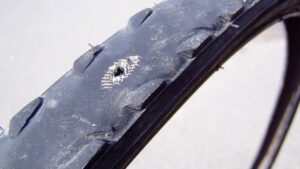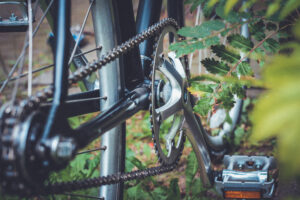
The 3rd annual virtual Tour de Tush is just around the corner, and that means it’s time to give your bike a routine check up! Let’s get ready to go biking, and raise awareness for colorectal cancer with some simple tips:
1.) Check your bike’s tires
No one likes riding with bad tires. It’s important to conduct routine inspections on your tires before you hit the road. Keep on the lookout for deep cuts, worn treads, bulges, or cracks. Whenever you see
casing, the nylon fabric on the inside of your tires that the tread sits on, that’s a sign to replace your tires.
However, small cracks or blemishes on your tires don’t mean it’s time to throw them out and get new ones. Cosmetic damage like small cuts from road debris, minor tread wear, or cracks are normal for tires over time. Remember, tires are durable!
2.) Lubricate your chain
You won’t get far without your bike chain, so ensuring it’s well lubricated, cleaned when needed, or replaced if your chain is stretched.
To start, you can tell if your bike chain needs more lube if it’s started squeaking while riding. Use bike-specific chain lube from your local bike shop, as these can come with applicators to make lubing your chain a breeze. Follow the directions on the bottle of your choice. Routine care for your chain will ensure you have a smooth ride, and ensure your bike is in good shape to get your Tour de Tush miles in!
When it comes to cleaning your bike chain, constant cleaning can harm it. Instead, lubrication is the best way to ensure your chain is a happy chain. To clean your chain, you can take an empty plastic bottle, insert the chain, and fill the bottle with degreaser, and shake. If your bike is more precise, there are other methods, such as wiping with a cloth, using speed degreaser, etc. It’s important to note that your chain likely doesn’t need to be cleaned. The best way to tell is if your chain is leaving marks on your leg, or has trouble shifting gears.
Unless you’re a frequent rider, or your bike’s chain has never been cleaned or inspected, you likely don’t need to replace your chain. If you’re unsure, contacting your local bike shop and bringing your bike in is the best way to go.
3.)Brake pads: get them replaced if they’re worn down
For the Tour de Tush, bike safety is our top priority. Brake pads are an easy way to ensure you’ll have a safe ride, especially when you’re riding on roads that have frequent stops.
You can identify a worn brake pad in a variety of ways. Usually, a sign that you need a new brake pad happens when you’re riding: grinding noises, or squealing when braking are easy indicators. You can also

On the left are new brake pads, which have raised grooves, and are taller than the ones on the right, which are visibly worn and shorter than the new pads.
look at the brake pads themselves and identify the wear. A new brake pad should be higher, and have grooves. Worn pads are lower, and missing grooves or patterns.
4.)Updating your helmet
Helmets expire! Replace your helmet every 5-7 years, or well before if your helmet doesn’t fit properly. A good helmet is snug, but not tight. Helmets should be worn with the strap secure, and securely on top of your head. Helmets that slide back, or forward, increase your risk for injury, and compromise the safety of the helmet. Visiting your local bike shop or outdoor supply store and getting outfitted with a helmet is the best way to go if you aren’t sure about the fit or safety of your current helmet.
Now that you’re up to speed on basic bike care and safety before you hit the pavement, why not get registered for the national Tour de Tush? Tour de Tush, starting May 1, 2023, is a month-long bike ride, raising awareness and funds for colorectal cancer research. Colon cancer impacts 1 in 24 Americans, and is on track to become the leading cause of cancer deaths by 2030. Join the cause today by registering here.
Sources:
The Ultimate Bicycle Owner’s Manual by Eben Weiss
Bike Radar: Bike Chains Explained
Total Women’s Cycling: How do I know when my bike pads need replacing?
Bike Radar: How to wear a bike helmet
REGISTER FOR TOUR DE TUSH TOUR DE TUSH PRESS RELEASE WHAT IS COLON CANCER?




